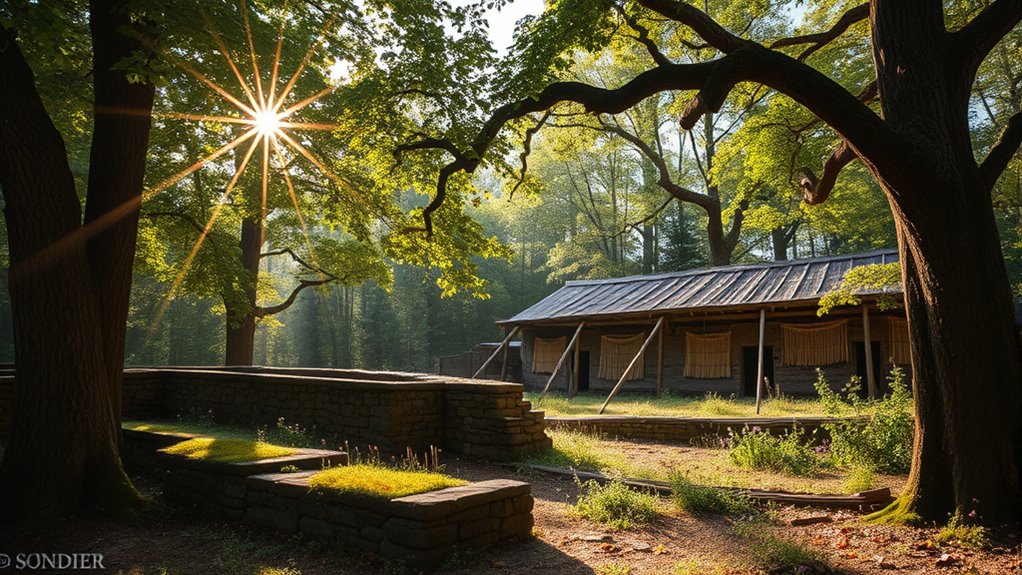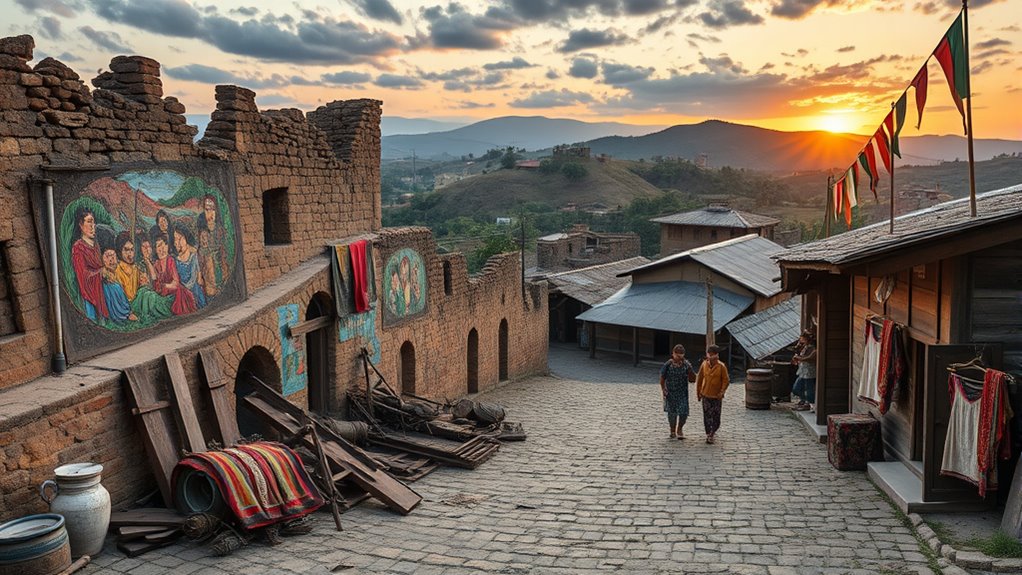The Northeast’s history and culture are shaped by Native American traditions, early colonial conflicts, and revolutionary ideals that fostered independence. You’ll see a legacy of innovation through its educational institutions like Harvard and Yale, along with a rich literary and artistic heritage. The region’s economy transformed from farming to industry, influencing urban growth and demographic diversity. If you keep exploring, you’ll uncover the fascinating stories that continue to define the Northeast today.
Key Takeaways
- The Northeast played a pivotal role in early American history, including Native conflicts, colonial governance, and revolutionary ideas.
- It was a center of industrial growth in the 19th century, transforming from farming to manufacturing and urbanization.
- The region hosts prestigious universities like Harvard and Yale, shaping educational and cultural development.
- Native American tribes fiercely resisted colonization, resulting in wars, treaties, and displacement shaping regional boundaries.
- Cultural contributions include influential literature, abolitionist movements, and ongoing innovations in arts and higher education.
Foundations of Colonial Settlement and Native Interactions

How did early Native American and colonist interactions shape the foundations of settlement in Northeast America? You play a key role in understanding how these relationships influenced early development. Native Americans shared essential survival skills, such as farming techniques and fishing methods, which helped colonists establish successful settlements like Plymouth in 1620. These exchanges fostered cooperation initially, but tensions soon grew over land and resources. Colonists relied heavily on Native knowledge to adapt to unfamiliar environments, often leading to dependency. However, conflicts emerged as settlers encroached on Native lands, fueling disputes and violence. These interactions laid the groundwork for regional growth, blending Native traditions with colonial practices. Despite cooperative beginnings, the relationship set the stage for ongoing struggles over land, sovereignty, and cultural influence in Northeast America.
Conflicts, Wars, and the Shaping of Regional Power

You see how Native resistance and rebellions challenged colonial expansion, forcing both sides to negotiate or clash. Colonial military alliances often shifted the balance of power, influencing land disputes and treaties. These conflicts shaped the region’s history, forging new boundaries and power dynamics that still resonate today. The evolution of home theatre technology also reflects broader shifts in cultural and technological landscapes.
Native Resistance and Rebellions
Native resistance and rebellions played a pivotal role in shaping the power dynamics of early New England. You witness Native tribes fiercely defending their land and way of life against encroaching settlers. The Pequot War (1636–1638) resulted in the brutal defeat and enslavement of the Pequot tribe, shifting regional control. King Philip’s War (1675–1678) saw Native alliances resist English expansion, leading to widespread destruction and Native displacement. These conflicts forced colonists to adapt military strategies and negotiate treaties, often displacing Native populations further. Native resistance challenged colonial authority, fueling fears and shaping policies that prioritized land acquisition and control. The rebellions underscore the persistent struggle for sovereignty, highlighting Native resilience amid overwhelming colonial pressures that redefined regional power structures. Additionally, these conflicts prompted the development of military tactics and policies that would influence future colonial and Native relations.
Colonial Military Alliances
Colonial military alliances played a crucial role in shaping the political landscape of early New England by uniting colonies against external threats and internal conflicts. The New England Confederation, formed in 1643, exemplifies this cooperation, providing a collective defense against Native American tribes and Dutch rivals. You see, colonies often pooled resources and coordinated military efforts, especially during conflicts like the Pequot War and King Philip’s War. Leaders like Captain John Mason led combined forces to defend settlements and secure territorial gains. These alliances reinforced a sense of regional identity and established early mechanisms for collective security. Although they faced challenges, such as internal disagreements and external pressures, these military partnerships laid the groundwork for future American federalism and regional cooperation. Additionally, the influence of these alliances extended into shaping the region’s military strategies and diplomatic relations for years to come.
Land Disputes and Treaties
The alliances forged among New England colonies often depended on clear control over land and resources, making land disputes a central issue in shaping regional power. You witness conflicts such as the Pequot War and King Philip’s War, which resulted in Native American displacement and altered territorial boundaries. Treaties like the Treaty of Hartford (1638) aimed to end hostilities but often favored colonists, leading to further land seizures. Key points include:
- Pequot War’s conquest and enslavement of tribe members
- King Philip’s War’s devastating impact on Native populations
- The Treaty of Hartford dividing Pequot lands among colonies
- Land grants and charters fueling colonial expansion
- Ongoing disputes over native land rights and sovereignty
- The cultural significance of these conflicts continues to influence regional identities today.
These conflicts and agreements laid the groundwork for regional dominance, shaping the power dynamics between colonists and Native Americans.
Political Evolution and Legal Foundations in Early New England

Early political development in New England laid a strong foundation for American self-governance, driven by settlers’ desire for autonomy and community consensus. You’ll see this in the creation of key documents and institutions, like the Fundamental Orders of Connecticut (1639), which served as one of America’s first written constitutions. The colonies formed alliances such as the New England Confederation (1643) to coordinate defense and governance. Laws and charters established local authority and religious frameworks, shaping social norms. Additionally, the emphasis on self-rule fostered a culture of community participation that influenced future American political principles. Below is a table illustrating key legal and political milestones:
| Year | Event | Significance |
|---|---|---|
| 1639 | Fundamental Orders of Connecticut | Earliest written constitution |
| 1643 | New England Confederation | Regional defense alliance |
| 1691 | Massachusetts absorbs Plymouth | Consolidation of colonial governance |
Economic Development and Industrial Transformation

You see how the Northeast’s economy shifted from farming and fishing to manufacturing in the 19th century. This rise of industry transformed the region into a hub for textiles, machine shops, and later, advanced technology. Today, the region continues to evolve, balancing historic industries with modern economic sectors.
Rise of Manufacturing
As manufacturing began to flourish in the Northeast, the region transformed from a primarily agrarian economy into a hub of industrial activity. Factories sprouted along rivers, powering new industries and attracting workers. You’d see bustling mills producing textiles, shoes, and machinery, fueling economic growth. Key developments included:
- Rapid expansion of textile mills in Massachusetts and Rhode Island
- Growth of shoe manufacturing in Connecticut
- Emergence of machine shops and tool production
- Development of transportation infrastructure like railroads and ports
- Shift from artisan crafts to mass production methods
This industrial boom reshaped cityscapes and created a skilled workforce, establishing the Northeast as America’s industrial heartland during the 19th century. It marked a pivotal move toward modern economic strength and urbanization.
Shift to Modern Economy
How did the Northeast shift from its industrial roots to a modern economy? You see, after years of thriving manufacturing and heavy industry, the region faced decline as production moved south and west in the 20th century. To stay competitive, the Northeast pivoted to technology, scientific research, and high-tech manufacturing. Financial services, healthcare, and education also grew, transforming cities into hubs for innovation and knowledge. You’ll find that industries like biotech, information technology, and advanced manufacturing now drive regional growth. This transition helped the Northeast adapt to global economic changes while preserving its rich history of innovation. Today, the region balances its industrial legacy with modern sectors, ensuring its economy remains dynamic and resilient amid shifting national and international landscapes. Additionally, investments in pet care and veterinary services have contributed to the region’s economic diversification and community well-being.
Cultural Milestones and Educational Heritage

The Northeast region has long been a cornerstone of America’s cultural and educational development, shaping national identity through landmark achievements. You can see its influence in pioneering institutions, literary contributions, and social movements. – Founded top-tier universities like Harvard (1636), Yale (1701), and Princeton (1746), setting the foundation for higher education. – Launched influential writers such as Emerson, Thoreau, and Dickinson, shaping American literature and thought. – Led the abolitionist movement, with figures like Frederick Douglass and Harriet Tubman advocating for freedom and equality. – Played a central role in the American Revolution, fostering ideas of independence and democracy. – Fostered cultural innovations, from colonial arts to modern theater and music, influencing national culture. – Its educational heritage continues to inspire advancements in learning and scholarship across the nation.
Demographic Changes and Migration Trends

Migration patterns in the Northeast have continuously shaped its demographic landscape, driven by economic opportunities, religious freedoms, and social upheavals. You see, early settlers moved within colonies seeking better land, religious refuge, or escape from persecution. These internal migrations led to new settlements, like Roger Williams’ Rhode Island for dissenters. Over time, waves of immigrants arrived from Europe—Irish, Italian, Jewish communities—fueling urban growth. Forced migrations, such as enslaved Africans, profoundly influenced the region’s diversity and economy. Social upheavals, including the Great Migration of African Americans during the 20th century, shifted demographics further. Migration also responded to industrial booms and declines, prompting people to move for jobs or to escape economic downturns. Overall, these migration trends created a dynamic, diverse population that continues to evolve today.
Frequently Asked Questions
How Did Native American Cultures Influence Colonial Governance Structures?
Native American cultures influenced colonial governance structures by introducing democratic practices like councils and consensus decision-making, which colonists adopted in their own governments. You see this in early New England, where Native traditions of communal leadership and negotiation shaped the development of town meetings and local councils. These practices helped establish participatory governance, fostering cooperation and collective decision-making that became central to colonial political life and laid groundwork for American democracy.
What Role Did Women Play in Early New England Society?
Women in early New England society were the backbone of their communities, holding family and social stability together like the roots of a mighty tree. They managed households, farmed, and spun cloth, often acting as mediators and caretakers. Women also participated in religious life and community decision-making, shaping the moral fabric of society. Their resilience and roles laid the groundwork for future social and political changes in the region.
How Did Religious Dissent Shape Social Conflicts in the Region?
Religious dissent in early New England sparked social conflicts by challenging established church authority and norms. You might have experienced tensions when dissenters like Anne Hutchinson or Roger Williams questioned Puritan teachings, leading to bans, exile, and heated debates. These conflicts fueled divisions within communities, prompting some to seek new settlements. Their dissent ultimately shaped the region’s evolving religious landscape and promoted ideas of individual conscience and religious freedom.
What Were the Long-Term Effects of Early Trade Policies?
You might think early trade policies fostered prosperity, but they actually set the stage for long-term economic struggles. By prioritizing regional self-sufficiency and restrictive regulations, they limited growth and innovation. Ironically, this isolation delayed industrial development, making the region vulnerable to economic shifts. Over time, these policies contributed to economic decline in the 20th century, forcing the Northeast to reinvent itself through manufacturing, technology, and financial services.
How Did Migration Patterns Impact Indigenous Land Rights?
You see that migration patterns greatly impacted indigenous land rights by pushing Native Americans off their territories through settlement expansion and conflicts. As colonists moved inland for farming, trade, and settlement, they often ignored treaties and native land claims, leading to displacement and loss of sovereignty. These patterns disrupted native communities, contributed to wars like King Philip’s War, and resulted in long-term marginalization of indigenous peoples in the region.
Conclusion
You’ve uncovered the incredible tapestry of Northeast history and culture—more vibrant than a rainbow, more complex than a maze! From Native alliances to epic conflicts, your journey through time reveals a region whose story is so rich, it could fill a thousand libraries. The Northeast’s evolution is a whirlwind of change, shaping the very soul of America. Get ready—this fascinating history will blow your mind and leave you craving even more!









